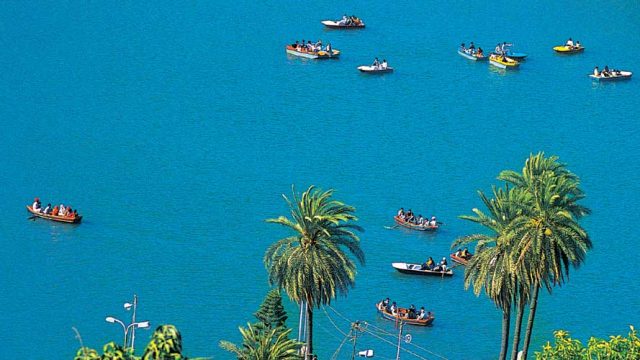Mount Abu’s past is as hoary as that of the rest of Rajasthan. It was here, according to legend, that a huge yagna was conducted by Sage Vashishta, who created the four agnikuls – the fire-born Rajput dynasties. The rest of the clans were said to have descended from the sun and the moon. The descendants of many of the royal houses that governed these Rajput clans built themselves summer palaces in Mount Abu, the coolest spot in overheated Rajasthan. Dozens followed their lead, and Mount Abu today hosts not just royalty on summer weekends, but also Rajasthan’s work-weary urbanites. It is also the top choice for many honey-mooners. Perhaps that has something to do with the lake at the heart of town, or the many points along the Aravalli ridge where the ambience is perfect to spend some memorable moments.
Things to see and do
Everybody who visits Mount Abu first hears of the pristine Nakki Lake. The town sits around this lake, which, according to local legend, the gods dug from the ground using their nails. There are various boats for rides, but the paddleboats are best.
For more sightseeing or trekking, head towards Toad Rock or Sunset Point. The latter is known for its panoramic views. At Guru Shikhar, the highest peak of the Aravallis, one may combine views of the range with homage at a small temple to Dattatreya (Shiva).

Wild Things
Mount Abu also boasts a wildlife reserve, spread over 288sq km, which is located 8km from the town. More than 250 species of birds fill the early morning air with birdsong here. The most common among them is the grey jungle fowl. In addition, leopards, sloth bears, chinkara, wild boars and hundreds of langurs also stalk the grounds. Trevor’s Tank is nearby, with densely wooded hills that are a haven for panthers, sambar and other jungle cats. You may just spot some animals having a drink from the tank as the sun sets.
Sanctuary timings Sunrise to sunset
Pilgrimage Points
The most important is clearly the marble Dilwara Jain temples, dating from the 11th–13th centuries and dedicated to the Jain tirthankaras. They have the most stupendous carved pillars, arches and ceilings that are a sight to behold. Near the Adhar Devi Temple is a natural spring that rushes through a sculpted cow’s head at Gaumukh. You can also pay your respects to Nandi, Shiva’s vahana, here.
WHERE TO STAY AND EAT
The summer palace of the erstwhile Maharaja of Jaipur is Jaipur House (Tel: 02974-235176; Tariff: ₹3,500–6,500). Cama Rajputana Club (Tel: 238205; Tariff: ₹7,000–10,750) is a heritage property. Connaught House (Tel: 238560, 235439; Tariff: ₹7,500) does garden lunches and picnic hampers.
Arbuda at Arbuda Circle has multicuisine fare. Café Shikibo offers good coffee and sandwiches. Jodhpur Bhojanalaya is also good.
THE INFORMATION
When to go Visit between Diwali and Christmas or in the spring
Tourist Office
Rajasthan Tourism, Opp Bus Stand, Mount Abu, Tel: 02974-235151, STD code 02974
GETTING THERE
Air Nearest airport: Udaipur (198km/ 3.5hrs). Taxi ₹4,000
Rail Abu Road Station (29km/ 1hr). Taxi ₹700. Shared jeeps and buses also available
Road From Udaipur, NH76 to Jharoli, NH14 to Abu Road and then hill road to Mount Abu




